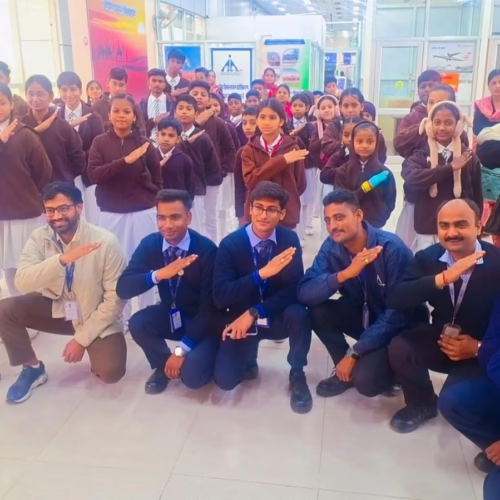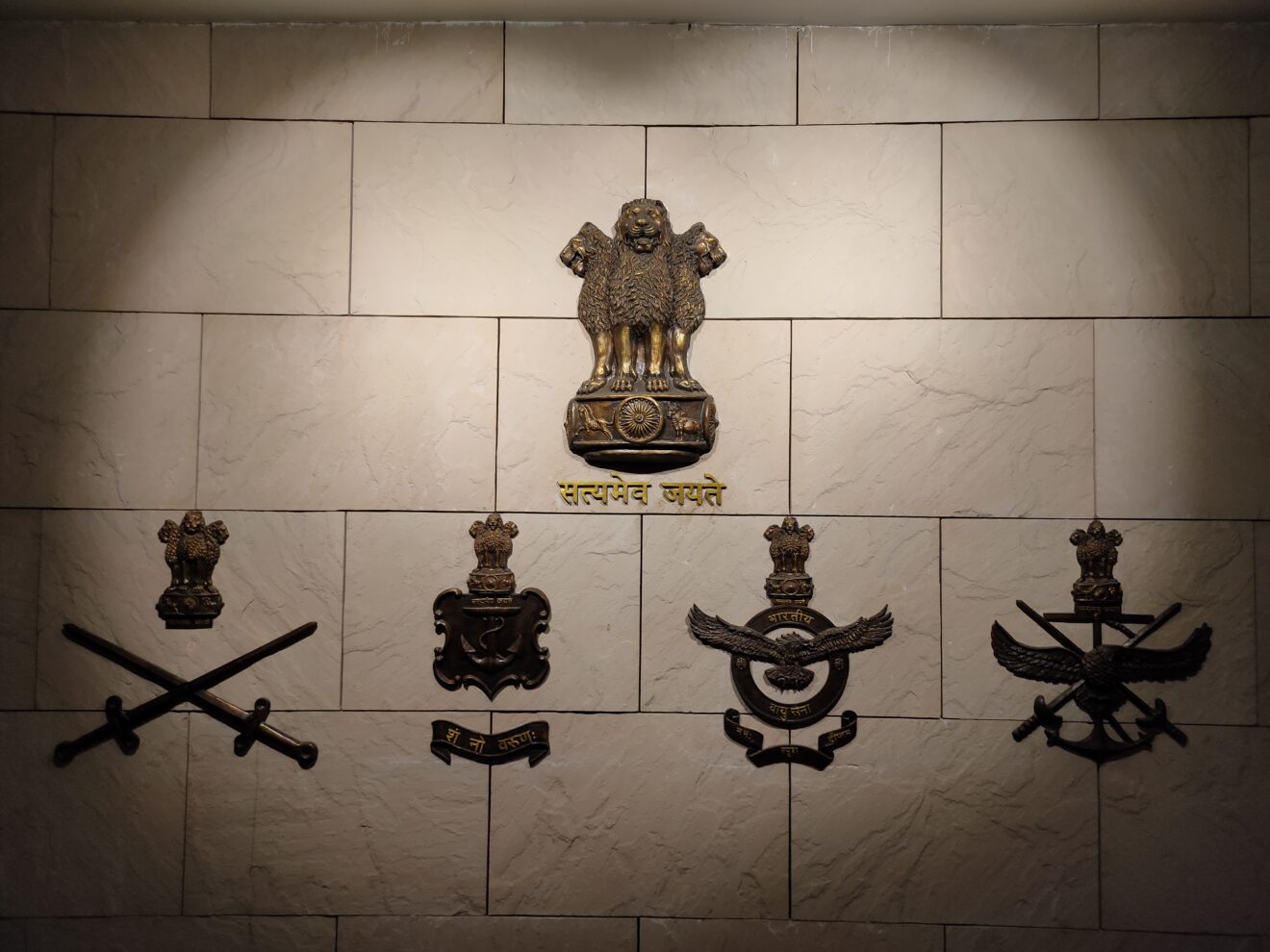Boeing E‑4B ‘Nightwatch’ — America’s “Doomsday” Flying Command Post Soars Over India’s South Coast
By Defence Journalist Sahil | T.I.N. Network
As dusk yielded to night and the southern skies of India loomed dark with the potential for global complication, an unmistakable silhouette cleaved through the airspace above the Indian peninsula. A four-engine jumbo jet, stripped of commercial trappings, immaculately painted in USAF livery, silently traced a westerly track across Karnataka and Tamil Nadu. The aircraft in question: a rare appearance of the United States Air Force’s E-4B Advanced Airborne Command Post, commonly dubbed the “Nightwatch” or “Doomsday Plane.”
On this occasion, this flying fortress — designed to keep America’s national command structure aloft even under extreme duress — had made a transit over the Indian subcontinent, triggering fresh questions and commentary from defence analysts, air-traffic watchers and strategic think-tanks alike.
What is the E-4B Nightwatch?
The Boeing E-4 series was conceived in the Cold War as a mobile, highly survivable platform for the National Command Authority of the United States — the President, the Secretary of Defense, and their successors.
Officially designated the “Advanced Airborne Command Post (AACP)”, it carries the operational codename “Nightwatch” and functions as a flying war-room, resilient against nuclear, electromagnetic and strategic threats.
Over the decades the E-4B has acquired the nickname “Doomsday Plane”, not for its capacity to initiate global destruction, but because it preserves the chain of command when ground centres may be destroyed.
Why Its Overflight Matters in the Indian Ocean Region
That an E-4B should transit near Indian airspace is noteworthy for multiple reasons. First, its mere presence underscores the U.S. strategic calculus of ensuring global reach for its command-and-control apparatus. Second, the Indian Ocean region is emerging as a tinderbox of great-power competition: naval deployments, nuclear signalling, and multi-domain operations are stacking up. A strategic asset such as the Nightwatch is a visible symbol of readiness.
From the Indian perspective, this incident is doubly interesting: one, because it offers insights into allied surveillance, tracking and air-space coordination (or the lack thereof) when such platforms traverse Indian approaches; two, because it offers a reminder of how far beyond its shore-lines New Delhi’s defence interests must struggle for situational awareness.
A Technical Brief: What the Aircraft Can Do
The E-4B’s capabilities are formidable and highly specialised. Some of its key attributes include:
- Based on the Boeing 747-200 airframe, extensively modified for military use and hardened against electromagnetic pulse (EMP), nuclear and thermal effects.
- Interior divided into multiple decks; on board are command work areas, briefing rooms, communication hubs, rest and berthing facilities for large crewmembers and staff — up to about 112 persons in some configurations.
- Global communication capability: satellite links, very low frequency (VLF) trailing-wire antennas for submarine communications, secure networks for strategic messaging.
- In-flight refuelling capability, enabling extended airborne endurance — potentially days aloft, limited principally by consumables and crew stamina.
- Operated by the USAF’s 595th Command & Control Group out of Offutt Air Force Base, Nebraska.
What Does Its Visit Imply for India’s Defence Observations?
While the precise mission profile of the flight remains unconfirmed (and such platforms often transit under discrete call-signs), several implications stand out for India’s defence and security community:
- Surveillance and Awareness Check: Indian air-defence and air-traffic units may use such appearances to validate tracking regimes, radar coverage, and coordination frameworks with civil aviation authorities.
- Deterrence and Signalling: The presence of a command-and-control node above or near a region signals to potential adversaries that the alliance behind it retains global command resilience. India must account for such signalling when planning its own maritime and aerial posture.
- Alliance Management: For India–U.S. defence cooperation, the movement of U.S. strategic platforms over or near the Indian Ocean may require diplomatic notifications, over‐flight agreements or cooperative tracking—even if covert.
- Strategic Messaging: In an era of hybrid warfare, where communication networks, satellites and command centres are under threat, seeing the E-4B in an operational posture emphasises the premium placed on continuity of command. India’s own forces, from air defence to cyber to maritime command, must emphasise redundancy accordingly.
Strategic Context: India’s Neighbourhood and the Indo-Pacific Chessboard
The Indian Ocean region has become the locus of multiple intersecting strategic currents: China’s maritime ambitions, India’s own blue‐water navy growth, U.S. naval and air force deployments, and emerging threats such as anti‐access/area-denial (A2/AD) zones, submarine operations, ballistic missile trajectories and electronic warfare. Within this milieu, a platform like the E-4B functions not simply as a warplane but as a theatre-shaping asset.
For instance, if a regional scenario triggered a conflict requiring coalition coordination, deep communication and resilience of command would become pivotal. From New Delhi’s vantage, watching allied platforms such as the Nightwatch implies the need to evolve India’s own airborne and ground-based command nodes, ensure space and cyber defences, and maintain situational awareness across domains—land, sea, air, space and information.
The Future: What Comes Next?
The E-4B, while still in service, is showing its age. According to recent announcements, the U.S. Air Force awarded a large contract (over US$13 billion) to the Sierra Nevada Corporation to develop its successor — part of the Survivable Airborne Operations Center (SAOC) programme.
For India, this transition offers two lessons: one, that such platforms can remain in service decades beyond their origin if maintenance, upgrades and redundancy are applied; two, that leadership-resilience through air, space and sea is a generational endeavour and not merely “buy a plane and done.”
Conclusion: A Silent Sky, A Loud Message
When the Nightwatch passes overhead it carries no bomb, no visible missile rack, no conventional thunder of ordinance. Yet its significance is loud: a reminder that in the age of strategic shock, conflict can begin not with fire but with disconnection—of command, of communication, of continuity.
India should view this transit not just as a curiosity of a foreign ally’s logistics, but as a tactical and strategic indicator: readiness is measured in silence and speed, in redundancy and resilience, in the ability to command when everything else has been disrupted. The sky above the Indian Ocean remains wide—and in that space, the Nightwatch writes another silent chapter of aerospace deterrence and command sovereignty.
बोइंग E-4B ‘नाइटवॉच’: भारत के दक्षिणी आसमान में दिखा अमेरिका का ‘डूम्सडे कमांड पोस्ट’
वैश्विक शक्ति राजनीति के बीच अदृश्य संकेतों की उड़ान
BY DEFENCE JOURNALIST SAHIL | T.I.N. NETWORK
न्यू दिल्ली | हिन्द महासागर क्षेत्र | अक्टूबर 2025 —
रात के नीले कैनवास पर एक चमकता हुआ धातु का विशाल पंछी, दक्षिण भारत के ऊपर उड़ते देखा गया। यह न Boeing 747 की कोई सामान्य यात्री उड़ान थी और न ही किसी सामान्य अमेरिकी सैन्य अभियान का हिस्सा। यह था संयुक्त राज्य अमेरिका के सामरिक तंत्र का सबसे गोपनीय और शक्तिशाली एयरबोर्न कमांड सेंटर: Boeing E-4B ‘Nightwatch’ — जिसे पूरी दुनिया Doomsday Plane के नाम से जानती है।
भारतीय हवाई क्षेत्र के दक्षिणी हिस्से में इस विमान की उपस्थिति ने भारतीय सुरक्षा तंत्र, सामरिक विशेषज्ञों, वैश्विक खुफिया जगत और भू-राजनीति के विश्लेषकों को चौंका दिया।
हर किसी के मन में एक ही सवाल उभर आया:
आखिर दुनिया का सबसे महत्वपूर्ण सैन्य नेतृत्व सुरक्षित रखने वाला यह विमान भारत के ऊपर क्या कर रहा था?
शीत युद्ध की देन, भविष्य के युद्ध का कमांडर
E-4B उस परिकल्पना पर आधारित है जहाँ जमीन पर स्थापित कमांड सेंटर, मिसाइल हमले या परमाणु युद्ध में नष्ट हो सकते हैं। ऐसी स्थिति में शीर्ष नेतृत्व को हवा में ही सुरक्षित रखकर पूरे सैन्य नेटवर्क का नियंत्रण बनाए रखना होता है।
इसी वजह से यह विमान केवल एक उड़ता हुआ एअरक्राफ्ट नहीं, बल्कि एक उड़ता हुआ पेंटागन है।
इसका इलेक्ट्रॉनिक शील्डिंग इसे EMP (Electromagnetic Pulse) प्रूफ बनाती है।
यह विमान वैश्विक कमांड-नियंत्रण क्षमता, मल्टी-लेयर संचार नेटवर्क और परमाणु युद्ध परिस्थितियों में भी सक्रिय रह सकने के लिए डिजाइन किया गया है।
सरल शब्दों में कहें तो:
धरती पर सभी सिस्टम ध्वस्त हो जाएँ, तब भी Nightwatch हवा से दुनिया की कमान संभाले रखेगा।
भारतीय आकाश में इसकी मौजूदगी का विशेष महत्व
भारत आज एक उभरती वैश्विक शक्ति है।
हिन्द-प्रशांत क्षेत्र बड़ी रणनीतिक प्रतिस्पर्धा के केंद्र में बदल चुका है।
अमेरिका के सबसे महत्वपूर्ण सैन्य प्लेटफॉर्म का यहाँ दिखना संयोग नहीं कहा जा सकता।
इसकी उपस्थिति कुछ गहरे संदेश देती है:
• अमेरिकी सैन्य कमान की सतत वैश्विक पहुँच
• हिन्द महासागर क्षेत्र में सामरिक तनाव और प्रतिस्पर्धा पर उच्च सतर्कता
• भारत-अमेरिका सुरक्षा संवाद के उच्च स्तर
• क्षेत्रीय विरोधियों (विशेषकर चीन और उसके साझेदारों) को रणनीतिक चेतावनी
अमेरिका इस क्षेत्र को कमजोरी का नहीं, अवसर और प्रभाव का मैदान बनाना चाहता है।
भारत-अमेरिका सामरिक समीकरण
पिछले कुछ वर्षों में दोनों देशों के बीच:
• इन्फॉर्मेशन शेयरिंग
• रक्षा प्रौद्योगिकी समझौते
• लॉजिस्टिक सपोर्ट
• साझा सैन्य अभ्यास
• इंडो-पैसिफिक साझेदारी
को नई गति मिल चुकी है।
Nightwatch का भारत के आसमान में दिखना यह संकेत भी हो सकता है कि
अमेरिका अब भारत को वैश्विक कमान संरचना के भरोसेमंद दायरे में देखने लगा है।
यह भरोसा भारत के भू-रणनीतिक महत्व पर आधारित है,
विशेषकर जब भारत:
• हिंद महासागर की समुद्री लाइनों का प्रहरी है
• चीन की Indo-Pacific विस्तारवादी रणनीति के विरुद्ध निर्णायक शक्ति माना जाता है
• दुनिया की उभरती अर्थव्यवस्था और सैन्य शक्ति है
उड़ता हुआ कमांड किला: अंदर क्या होता है?
बाहर से यह भले Boeing 747 जैसा दिखता है,
अंदर यह पूरी तरह युद्धग्रस्त दुनिया का नियंत्रण केंद्र है।
विमान के हर डेक को इस तरह गढ़ा गया है कि:
• सैन्य संचालन निरंतर चलते रहें
• राष्ट्रपति और शीर्ष कमान सुरक्षित रहें
• पूरी दुनिया में फैले सैन्य नेटवर्क से संपर्क बना रहे
यह उड़ान में ऊर्जा प्राप्त (Aerial Refueling) करके लगातार कई दिनों,
यहाँ तक कि आवश्यकता पड़ने पर कई हफ्तों तक हवा में रह सकता है।
किसी भी वैश्विक संकट में यह विमान उठते ही अमेरिकी सैन्य नीति में “समय का चक्र” बदल सकता है।
भारत के लिए सबक: भविष्य कमांड को बचाने की लड़ाई है
ये उड़ानें भारत को चेतावनी और मार्गदर्शन, दोनों देती हैं।
भारतीय सुरक्षा प्रणाली को यह समझने की आवश्यकता है कि:
• भविष्य का युद्ध केवल मिसाइलों और टैंकों की लड़ाई नहीं
• यह कमान, नियंत्रण, साइबर, स्पेस और सिग्नल सर्वाइवल की जंग होगी
• शीर्ष नेतृत्व के जीवित और सक्रिय रहने का तंत्र अत्यंत आवश्यक है
• राष्ट्रीय स्तर पर एक Airborne Resilient Command Capability भविष्य की जरूरत है
आज चीन पहले ही
एंटी-सैटेलाइट (ASAT) सिस्टम, साइबर टेक्नोलॉजी और इलेक्ट्रॉनिक युद्ध क्षमता बढ़ा चुका है।
भारत को भी समानांतर सामरिक संरचना विकसित करनी होगी।
SAOC प्रोग्राम: अगले युग की तैयारी
E-4B लगभग आधी सदी पुरानी डिजाइन पर आधारित है।
फिर भी लगातार उन्नयन से यह आज भी दुनिया का सबसे उन्नत कमांड प्लेटफॉर्म है।
अमेरिका अब SAOC — Survivable Airborne Operations Center
नामक अगली पीढ़ी तैयार कर रहा है,
जो डिजिटल-युद्ध के युग के लिए और भी मजबूत तथा अजेय होगी।
भारत जैसे देशों के लिए यह संकेत है कि
कमांड की सुरक्षा भविष्य का श्रेष्ठतम हथियार है।
मौन उड़ान, गहरा संदेश
Nightwatch की उड़ान में कोई शोर नहीं था
न हथियारों की चमक, न चेतावनी की गरज।
फिर भी वह आकाश में
शक्ति-राजनीति का सबसे बड़ा वक्तव्य दर्ज कर गया।
हिंद महासागर क्षेत्र में
महाशक्तियों की नई शतरंज बिछ चुकी है।
भारत को इस उड़ान को
केवल एक सैन्य गतिविधि नहीं,
बल्कि अपने भविष्य की तैयारियों का संकेत मानना चाहिए।
आसमान में शांत उड़ता यह विमान
एक बात बहुत साफ कह गया:
सुरक्षा का असली अर्थ
युद्ध की शुरुआत में नहीं
बल्कि कमान की निरंतरता में छिपा होता है।














Add Comment